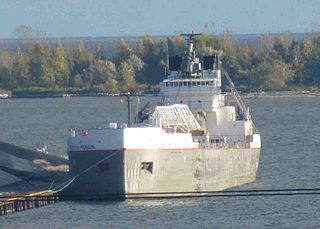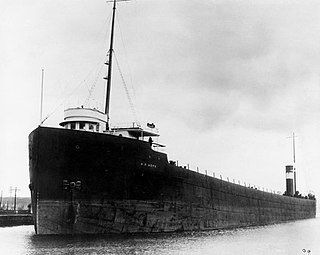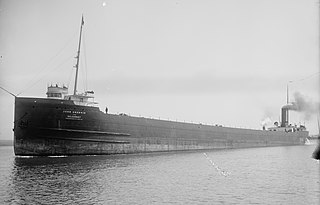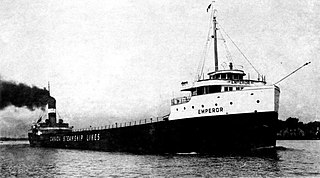
Lake freighters, or lakers, are bulk carrier vessels that operate on the Great Lakes of North America. These vessels are traditionally called boats, although classified as ships.
The Defoe Shipbuilding Company was a small ship builder established in 1905 in Bay City, Michigan, United States. It ceased to operate in 1976 after failing to renew its contracts with the United States Navy. The site of the former company is now being developed for business and housing on the bank of the Saginaw River.

SS Milwaukee Clipper, also known as SS Clipper, and formerly as SS Juniata, is a retired passenger ship and automobile ferry that sailed under two configurations and traveled on all of the Great Lakes except Lake Ontario. The vessel is now docked in Muskegon, Michigan.

The Robert S. Pierson is a bulk carrier built for and operated on the North American Great Lakes.

The lake freighter MV Saginaw was launched as John J. Boland in 1953, the third vessel to bear that name. John J. Boland was owned and operated by the American Steamship Company and constructed by Manitowoc Shipbuilding Company at Manitowoc, Wisconsin. In 1999, the ship was sold to Lower Lakes Towing and renamed Saginaw. The ship is currently in service.

The SS St. Marys Challenger is a freight-carrying vessel operating on the North American Great Lakes built in 1906. Originally an ore boat, she spent most of her career as a cement carrier when much larger ore boats became common. After a 107-year-long working career as a self-propelled boat, she was converted into a barge and paired with the tug Prentiss Brown as an articulated tug-barge. Before conversion, she was the oldest operating self-propelled lake freighter on the Great Lakes, as well as being one of the last freight-carrying vessels on the Great Lakes to be powered by steam engines.

The Calumet was the second lake freighter of that name. The vessel was built in Detroit, Michigan, in 1929, by the Great Lakes Engineering Works. For her first 71 years she was operated by two subsidiaries of US Steel, the Pittsburgh Steamship Company, and the Bradley Transportation Company. She was christened the Myron C. Taylor after one of the directors of US Steel, Myron Charles Taylor.

Augustus B. Wolvin was a 560 ft (170 m) long Great Lakes freighter that had a 63-year career on the Great Lakes. Augustus B. Wolvin was a product of the American Shipbuilding Company of Cleveland, Ohio. She was built for the Acme Steamship Company of Duluth, Minnesota.

The SS William G. Mather was a 533-foot (162 m) long Great Lakes freighter that was built in 1905, by the Great Lakes Engineering Works (GLEW) of Ecorse, Michigan, for the Grand Island Steamship Company. Her keel was laid on May 18, 1905. She was launched on September 23, 1905, as hull #9. The ship was named after William G. Mather, the Cleveland-Cliffs executive. She was powered by a 2,000-horsepower (1,500 kW) triple expansion steam engine which was attached to a single fixed-pitch propeller. She was fueled by two coal-fired Scotch marine boilers.

Howard L. Shaw was a 451-foot (137 m) long propeller driven freighter that operated on the Great Lakes of North America from her launching in 1900 to her retirement 1969. She is currently serving as a breakwater in Ontario Place on Lake Ontario.

The H.P. Bope was an American steel-hulled, propeller-driven Great Lakes freighter built in 1907 by the Superior Shipbuilding Company of Superior, Wisconsin for service on the Great Lakes of North America. She was used to transport bulk cargoes such as coal, iron ore and grain.

The Henry A. Hawgood was an American steel-hulled, propeller-driven lake freighter that was built by the American Ship Building Company of Cleveland, Ohio for service on the Great Lakes of North America and Canada. She was used to haul bulk cargoes such as iron ore, coal and grain.

The John Sherwin was an American steel-hulled, propeller-driven Great Lakes freighter built in 1906 by the West Bay City Shipbuilding Company of Bay City, Michigan for service on the Great Lakes of North America. She was used to transport bulk cargoes such as coal, iron ore and grain. She served from her launching in 1906 to her scrapping in 1974, in Germany.

SS Onoko was an iron hulled Great Lakes freighter. She was launched in 1882 in Cleveland, Ohio as hull number #4, and sank on September 14, 1915 in Lake Superior near Knife River, Minnesota. Onoko is thought to be the prototype for every single steel hulled Great Lakes Bulk carrier that ever sailed. These vessels made possible the cheap transport of bulk cargoes such as iron ore, coal and limestone. Her wreckage still remains on the bottom of Lake Superior and was listed on the National Register of Historic Places in 1992.

The Henry Phipps was a 601-foot-long (183 m) American Great Lakes freighter that served on the Great Lakes of North America from her launching in 1907 to her scrapping in 1976 by Hyman Michaels Company of Duluth, Minnesota. The Phipps was used to haul bulk cargoes such as iron ore, coal, grain and occasionally limestone.
Lake Frampton was a steam cargo ship built in 1918 by American Shipbuilding Company of Lorain for the United States Shipping Board (USSB) as part of the wartime shipbuilding program of the Emergency Fleet Corporation (EFC) to restore the nation's Merchant Marine. The vessel was employed in coastal trade during her career and collided with another steamer, SS Comus, and sank in July 1920 on one of her regular trips with a loss of two men.
















